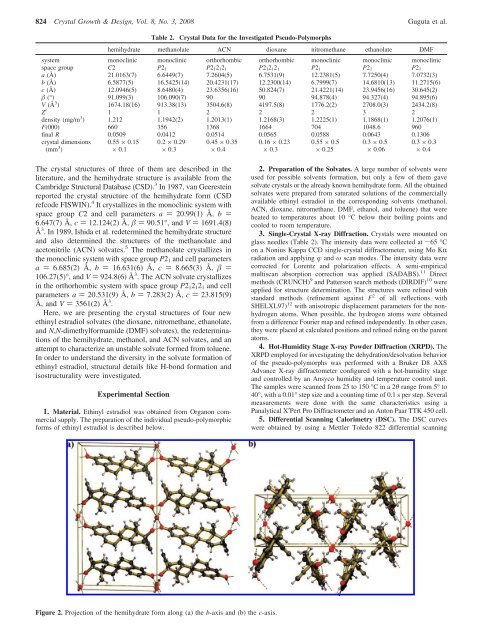Structural Diversity of Ethinyl Estradiol Solvates
Structural Diversity of Ethinyl Estradiol Solvates
Structural Diversity of Ethinyl Estradiol Solvates
You also want an ePaper? Increase the reach of your titles
YUMPU automatically turns print PDFs into web optimized ePapers that Google loves.
824 Crystal Growth & Design, Vol. 8, No. 3, 2008 Guguta et al.<br />
Table 2. Crystal Data for the Investigated Pseudo-Polymorphs<br />
hemihydrate methanolate ACN dioxane nitromethane ethanolate DMF<br />
system monoclinic monoclinic orthorhombic orthorhombic monoclinic monoclinic monoclinic<br />
space group C2 P2 1 P2 12 12 1 P2 12 12 1 P2 1 P2 1 P2 1<br />
a (Å) 21.0163(7) 6.6449(7) 7.2604(5) 6.7531(9) 12.2381(5) 7.7250(4) 7.0732(3)<br />
b (Å) 6.5877(5) 16.5425(14) 20.4231(17) 12.2300(14) 6.7999(7) 14.6810(13) 11.2715(6)<br />
c (Å) 12.0946(5) 8.6480(4) 23.6356(16) 50.824(7) 21.4221(14) 23.9456(16) 30.645(2)<br />
β (°) 91.099(3) 106.090(7) 90 90 94.878(4) 94.327(4) 94.895(6)<br />
V (Å 3 ) 1674.18(16) 913.38(13) 3504.6(8) 4197.5(8) 1776.2(2) 2708.0(3) 2434.2(8)<br />
Z′ 1 1 2 2 2 3 2<br />
density (mg/m 3 ) 1.212 1.1942(2) 1.2013(1) 1.2168(3) 1.2225(1) 1.1868(1) 1.2076(1)<br />
F(000) 660 356 1368 1664 704 1048.6 960<br />
final R 0.0509 0.0412 0.0514 0.0565 0.0588 0.0643 0.1306<br />
crystal dimensions<br />
(mm 3 )<br />
0.55 × 0.15<br />
× 0.1<br />
0.2 × 0.29<br />
× 0.3<br />
0.45 × 0.35<br />
× 0.4<br />
0.16 × 0.23<br />
× 0.3<br />
0.55 × 0.5<br />
× 0.25<br />
0.3 × 0.5<br />
× 0.06<br />
0.3 × 0.3<br />
× 0.4<br />
The crystal structures <strong>of</strong> three <strong>of</strong> them are described in the<br />
literature, and the hemihydrate structure is available from the<br />
Cambridge <strong>Structural</strong> Database (CSD). 3 In 1987, van Geerestein<br />
reported the crystal structure <strong>of</strong> the hemihydrate form (CSD<br />
refcode FISWIN). 4 It crystallizes in the monoclinic system with<br />
space group C2 and cell parameters a ) 20.99(1) Å, b )<br />
6.647(7) Å, c ) 12.124(2) Å, β ) 90.51°, and V ) 1691.4(8)<br />
Å 3 . In 1989, Ishida et al. redetermined the hemihydrate structure<br />
and also determined the structures <strong>of</strong> the methanolate and<br />
acetonitrile (ACN) solvates. 5 The methanolate crystallizes in<br />
the monoclinic system with space group P2 1 and cell parameters<br />
a ) 6.685(2) Å, b ) 16.631(6) Å, c ) 8.665(3) Å, β )<br />
106.27(5)°, and V ) 924.8(6) Å 3 . The ACN solvate crystallizes<br />
in the orthorhombic system with space group P2 1 2 1 2 1 and cell<br />
parameters a ) 20.531(9) Å, b ) 7.283(2) Å, c ) 23.815(9)<br />
Å, and V ) 3561(2) Å 3 .<br />
Here, we are presenting the crystal structures <strong>of</strong> four new<br />
ethinyl estradiol solvates (the dioxane, nitromethane, ethanolate,<br />
and N,N-dimethylformamide (DMF) solvates), the redeterminations<br />
<strong>of</strong> the hemihydrate, methanol, and ACN solvates, and an<br />
attempt to characterize an unstable solvate formed from toluene.<br />
In order to understand the diversity in the solvate formation <strong>of</strong><br />
ethinyl estradiol, structural details like H-bond formation and<br />
isostructurality were investigated.<br />
Experimental Section<br />
1. Material. <strong>Ethinyl</strong> estradiol was obtained from Organon commercial<br />
supply. The preparation <strong>of</strong> the individual pseudo-polymorphic<br />
forms <strong>of</strong> ethinyl estradiol is described below.<br />
2. Preparation <strong>of</strong> the <strong>Solvates</strong>. A large number <strong>of</strong> solvents were<br />
used for possible solvents formation, but only a few <strong>of</strong> them gave<br />
solvate crystals or the already known hemihydrate form. All the obtained<br />
solvates were prepared from saturated solutions <strong>of</strong> the commercially<br />
available ethinyl estradiol in the corresponding solvents (methanol,<br />
ACN, dioxane, nitromethane, DMF, ethanol, and toluene) that were<br />
heated to temperatures about 10 °C below their boiling points and<br />
cooled to room temperature.<br />
3. Single-Crystal X-ray Diffraction. Crystals were mounted on<br />
glass needles (Table 2). The intensity data were collected at -65 °C<br />
on a Nonius Kappa CCD single-crystal diffractometer, using Mo KR<br />
radiation and applying φ and ω scan modes. The intensity data were<br />
corrected for Lorentz and polarization effects. A semi-empirical<br />
multiscan absorption correction was applied (SADABS). 11 Direct<br />
methods (CRUNCH) 9 and Patterson search methods (DIRDIF) 10 were<br />
applied for structure determination. The structures were refined with<br />
standard methods (refinement against F 2 <strong>of</strong> all reflections with<br />
SHELXL97) 12 with anisotropic displacement parameters for the nonhydrogen<br />
atoms. When possible, the hydrogen atoms were obtained<br />
from a difference Fourier map and refined independently. In other cases,<br />
they were placed at calculated positions and refined riding on the parent<br />
atoms.<br />
4. Hot-Humidity Stage X-ray Powder Diffraction (XRPD). The<br />
XRPD employed for investigating the dehydration/desolvation behavior<br />
<strong>of</strong> the pseudo-polymorphs was performed with a Bruker D8 AXS<br />
Advance X-ray diffractometer configured with a hot-humidity stage<br />
and controlled by an Ansyco humidity and temperature control unit.<br />
The samples were scanned from 25 to 150 °C ina2θ range from 5° to<br />
40°, with a 0.01° step size and a counting time <strong>of</strong> 0.1 s per step. Several<br />
measurements were done with the same characteristics using a<br />
Panalytical X′Pert Pro Diffractometer and an Anton Paar TTK 450 cell.<br />
5. Differential Scanning Calorimetry (DSC). The DSC curves<br />
were obtained by using a Mettler Toledo 822 differential scanning<br />
Figure 2. Projection <strong>of</strong> the hemihydrate form along (a) the b-axis and (b) the c-axis.
















